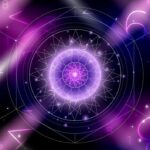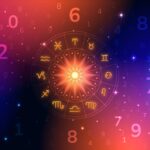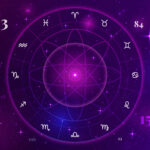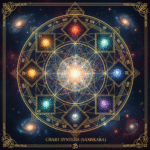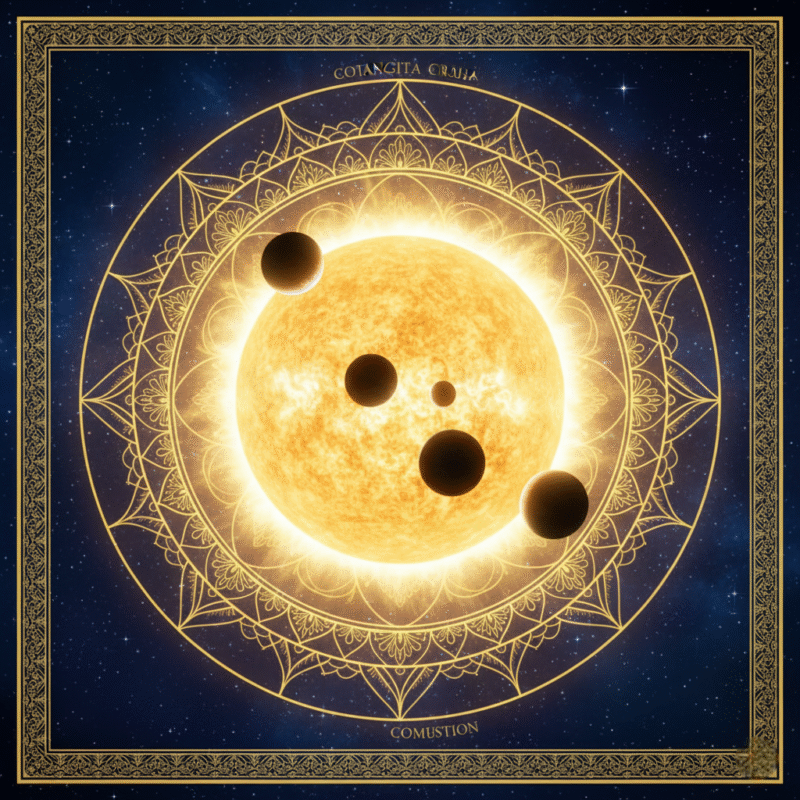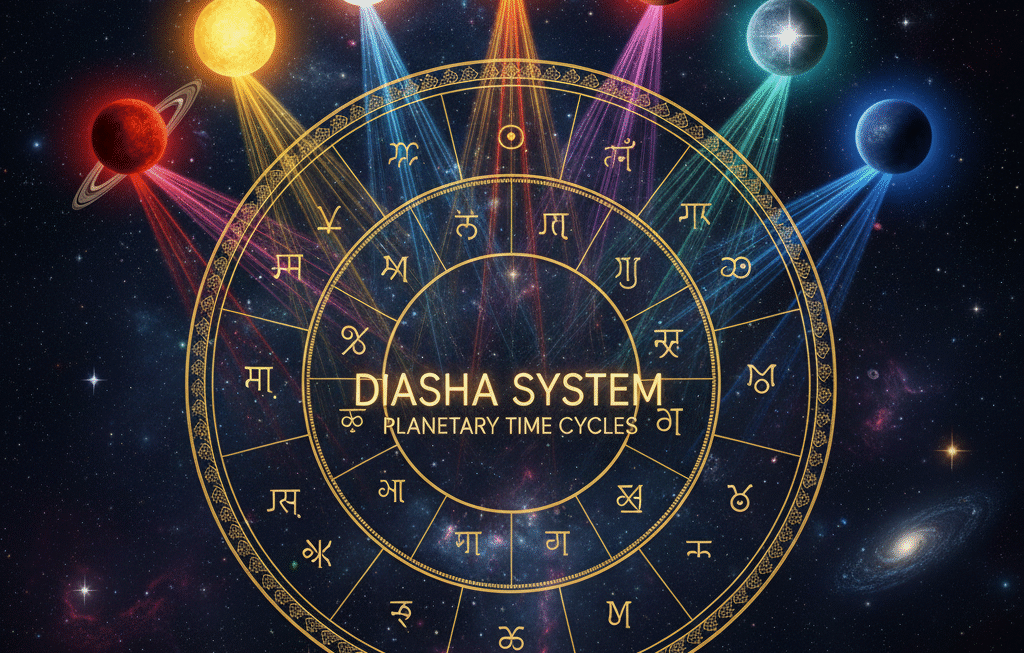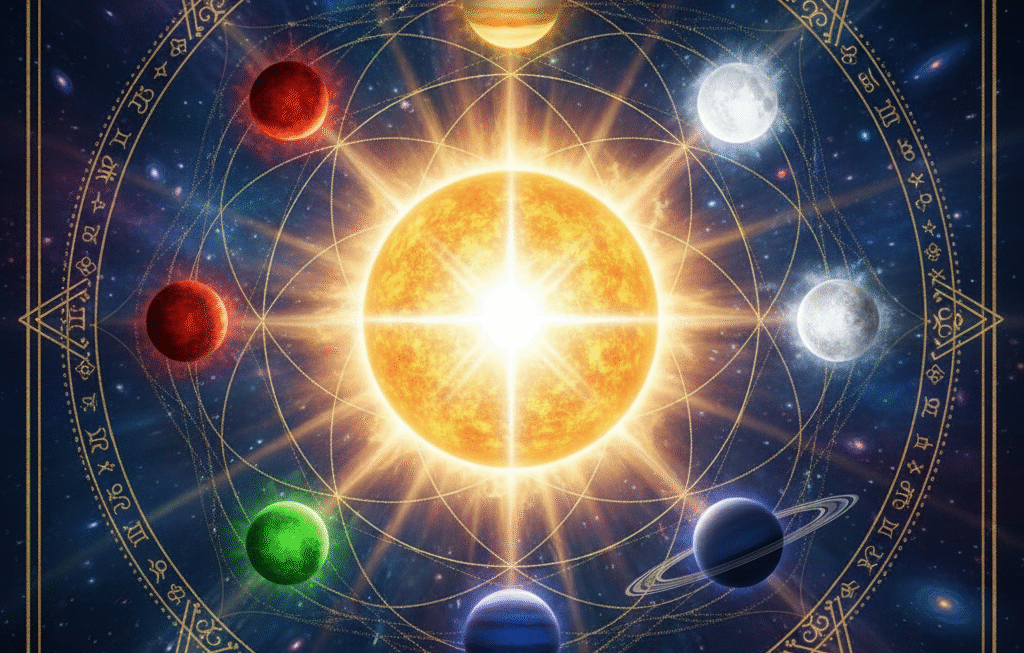Have you ever noticed planets clustered near the Sun in your Vedic birth chart and wondered why astrologers call them “combust” or “burnt”? This phenomenon is known as Planetary Combustion — or Astangata Graha in Sanskrit — a powerful concept that can change how a planet behaves in your life.
In this guide, we’ll explore:
- What combustion means in Vedic astrology
- Which planets get affected and at what distance
- How to identify combustion in your chart
- What it means spiritually and practically
By the end, you’ll be able to spot combust planets in your own Kundli and understand what their hidden messages mean.
Step 1: What Is Planetary Combustion (Astangata Graha)?
(Focus Keyword: planetary combustion)
In Vedic astrology, combustion (Sanskrit: Astangata, “setting of the planet”) occurs when a planet comes too close to the Sun in the zodiac.
Just as physical proximity to the Sun burns anything in reality, a planet near the Sun in your chart gets overpowered by the Sun’s brilliance.
The result?
The planet’s light, energy, and independent influence become weaker — its voice gets overshadowed by the Sun’s authority.
Step 2: The Concept of “Astangata” — When a Planet “Sets”
The word Astangata (अस्तंगत) literally means “to set” or “to disappear.”
In ancient astrology, when planets came too close to the Sun, they were said to “lose their form” — symbolically, they couldn’t be seen from Earth.
Thus, combustion represents loss of visibility = loss of strength.
In a birth chart, this means that planet’s qualities may become muted, suppressed, or internalized — often leading to lessons in humility and detachment.
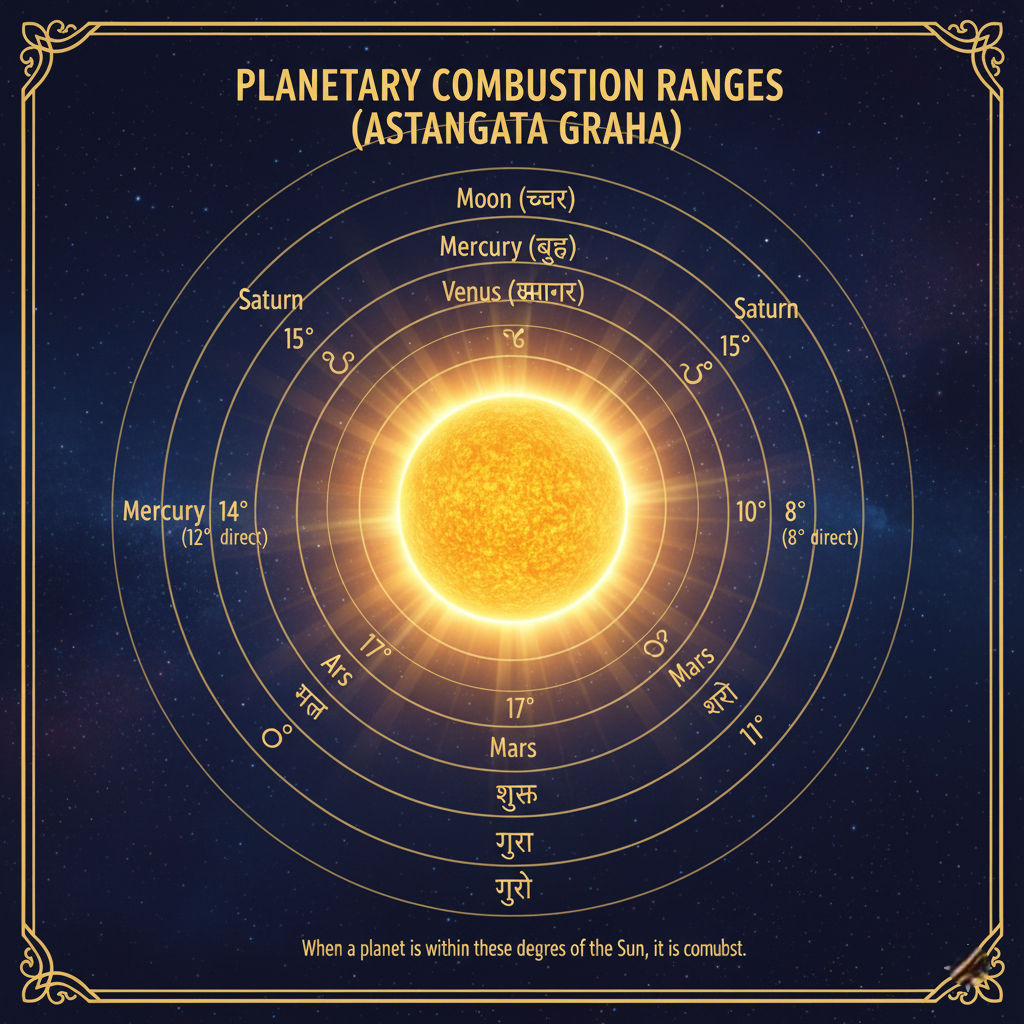
Step 3: Degrees of Combustion for Each Planet
(Focus Keyword: combust planets vedic)
Different planets combust at different distances from the Sun. Here’s what classical Jyotish texts tell us:
| Planet | Degrees from Sun (Approx.) | Effect |
| 🌙 Moon | Within 12° | Emotional sensitivity, lack of clarity |
| ☿ Mercury | Within 14° (direct), 12° (retrograde) | Nervous tension, overthinking, scattered thoughts |
| ♀ Venus | Within 10° | Difficulty expressing love, relationship intensity |
| ♂ Mars | Within 17° | Impatience, aggression, lack of direction |
| ♃ Jupiter | Within 11° | Reduced wisdom, difficulty with judgment or faith |
| ♄ Saturn | Within 15° | Weak discipline, internalized fears or duties |
🪷 Note: Rahu and Ketu — being shadow planets — do not combust.
Step 4: The Logic Behind Combustion — Why Does It Happen?
The Sun represents the Atman — the Self, ego, and vitality.
When other planets come close, their light gets lost in the Sun’s brilliance.
Metaphorically, it’s like standing next to a king — your own individuality fades.
- Mercury near the Sun: Mind overwhelmed by constant thinking or pride in intellect.
- Venus near the Sun: Desires and relationships lose clarity, replaced by ego in love.
- Mars near the Sun: Anger or willpower turns impulsive.
- Jupiter near the Sun: Wisdom overshadowed by authority or self-righteousness.
- Saturn near the Sun: Responsibility becomes heavy; duty feels personal and isolating.
Step 5: How to Identify Combust Planets in Your Chart
(Focus Keyword: planets near sun astrology)
Follow these steps to find combustion in your Vedic birth chart (Kundli):
- Locate the Sun’s position — note the sign and degree.
- Check each planet’s degree in the same or neighboring sign.
- Calculate the difference between the Sun’s degree and that planet’s degree.
- If it falls within the combustion range (from the table above), that planet is combust.
Example:
If your Sun is at 15° Leo and Venus is at 22° Leo, the difference is 7°.
Since Venus combusts within 10° — it is combust.
You can use any free Vedic astrology software or chart generator that lists planetary degrees for accuracy.
Step 6: OREO Breakdown of Combustion
Let’s decode this through the OREO Framework —
Opinion:
Combustion doesn’t destroy a planet — it transforms its power from outer expression to inner reflection.
Reason:
Because the Sun symbolizes ego and illumination, any planet near it loses personal autonomy, forcing the native to internalize that planet’s qualities.
Example:
Venus combust near the Sun may bring love lessons — the person learns to love without attachment or pride.
Restate:
Thus, combustion is less about loss and more about refinement. The fire of the Sun purifies, even as it burns.
Step 7: Effects of Combustion by Planet
| Planet | Nature When Combust | Typical Inner Lessons |
| Mercury | Over-anxious, self-critical, brilliant but restless | Learn to quiet the mind, listen before speaking |
| Venus | Passionate yet misunderstood, artistic conflicts | Learn to value love over vanity |
| Mars | Rash or ego-driven, heated emotions | Learn controlled strength and patience |
| Jupiter | Questioning beliefs, testing wisdom | Develop humility and faith |
| Saturn | Inner pressure, fear of failure, over-responsibility | Learn to release burdens and trust timing |
| Moon | Emotional instability, identity confusion | Cultivate stillness, connect to intuition |
Step 8: Combustion vs. Conjunction — Don’t Confuse Them!
(Focus Keyword: combust planets)
While both mean planets are close together, there’s a difference:
| Term | Meaning | Key Feature |
| Conjunction (Yuti) | Planets in the same house/sign | May cooperate or clash depending on friendship |
| Combustion (Astangata) | Planet too close to the Sun | Planet’s strength gets weakened or internalized |
All combust planets are in conjunction with the Sun —
but not all conjunctions are combust.
Step 9: Remedies & Balance for Combust Planets
A combust planet isn’t “bad” — it’s inwardly charged. The goal is to balance its energy consciously.
Remedies (Traditional & Modern)
- Sun-Mercury (Budha Astangata): Meditation, journaling, chanting Om Budhaya Namah, wearing emerald (if suitable).
- Sun-Venus (Shukra Astangata): Practice non-attachment in relationships; chanting Om Shukraya Namah.
- Sun-Mars (Mangal Astangata): Exercise discipline; recite Hanuman Chalisa or chant Om Mangalaya Namah.
- Sun-Jupiter (Guru Astangata): Study spiritual texts; chant Om Gurave Namah.
- Sun-Saturn (Shani Astangata): Accept responsibilities without pride; chant Om Sham Shanicharaya Namah.
Remember: the deeper the combustion, the greater the potential for inner mastery.
Step 10: Spiritual Meaning of Combustion — The Alchemy of Ego
From a higher perspective, planetary combustion isn’t punishment — it’s purification.
The Sun symbolizes the Atman — the divine self. When another planet gets close, it’s like that energy is being pulled back to source.
This process can manifest as:
- Ego dissolution
- Refinement of desires
- Spiritual insight through struggle
Thus, combust planets teach humility, surrender, and detachment — the very path toward enlightenment.
Step 11: Case Example — Venus Combust in Leo
Let’s bring it all together with an example.
A person with Venus combust in Leo (within 6° of the Sun) might:
- Crave admiration in love (Leo Sun)
- Feel unseen or unappreciated in relationships (Venus combust)
- Develop a deep sense of self-worth independent of others (the Sun purifies Venus’ desires)
Over time, such natives learn that true love isn’t about validation — it’s about self-expression and integrity.
That’s the deeper gift of combustion: transformation through light.
Final Thought: The Sun Doesn’t Destroy — It Refines
When a planet gets too close to the Sun, it’s not burnt to ashes — it’s forged like gold in fire.
So if your chart has combust planets, remember:
- You’re learning self-mastery through surrender.
- You’re meant to shine — but with inner light, not borrowed brilliance.
As ancient texts remind us — “The Sun burns, but also illuminates.”
Combustion is the crucible where your soul learns how to shine without losing itself.

